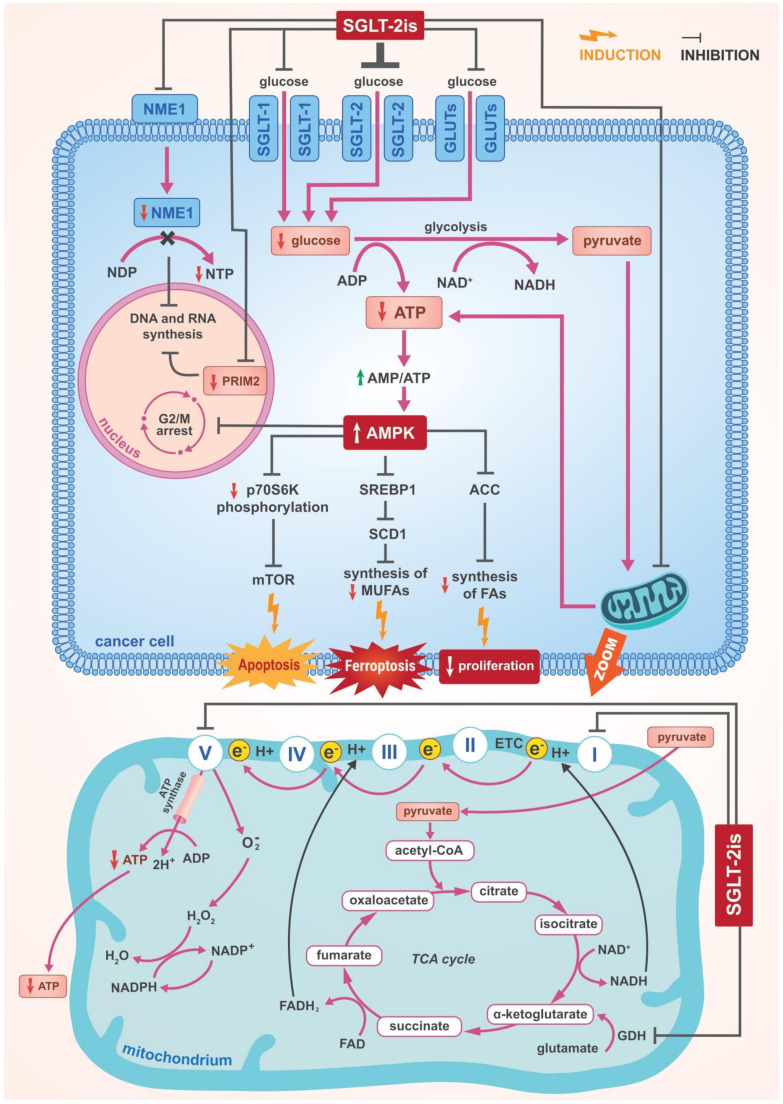Figure 2.
The main mechanisms of anti-cancer action of SGLT-2 inhibitors including the central role of AMPK activation. SGLT-2 inhibitors indirectly activate AMPK in cancer cells. SGLT-2 inhibitors, by inhibiting the oxidative phosphorylation, decrease ATP production and thus increase the AMP/ATP ratio. This leads to AMPK activation. SGLT-2 inhibitors affect oxidative phosphorylation. SGLT-2 inhibitors downregulate the alpha subunit of ATP synthase F1 and inhibit mitochondrial complex-I which leads to a significant decrease in ATP production in cancer cells. This results in an increase in the AMP/ATP ratio, which in turn causes a rapid and significant increase in AMPK activity. Another mechanism of action of SGLT-2 inhibitors, related to their effect on glutamine metabolism, also contributes to the increase in the AMP/ATP ratio. Glutamine is converted to glutamate, which is the carbon source for the TCA cycle. SGLT-2 inhibitors inhibit GDH activity, resulting in a significant decrease in intracellular alpha-ketoglutarate concentration. A fall in alpha-ketoglutarate concentration results in a reduction in its incorporation into the TCA cycle and consequently a decrease in the production of NADH and NADPH. Reduced NADH concentration results in reduced ATP production leading to AMPK activation, while reduced NADPH concentration results in impaired mitochondrial antioxidant defence. The SGLT-2 inhibitor-induced increase in AMPK activity results in multidirectional consequences in cancer cells. One of them is a significant increase in ACC phosphorylation and another one is inhibition of mTOR. ACC phosphorylation leads to its inhibition and thus SGLT-2 inhibitors rapidly inhibit fatty acid synthesis in cancer cells, resulting in the suppression of proliferation of these cells. Inhibition of mTOR is thought to be at least partly responsible for the suppression of proliferation and for induction of apoptosis in cancer cells. In addition, SGLT-2 inhibitor-induced AMPK activation results in the inhibition of SREBP1. The activation of AMPK inhibits SREBP1, which leads to the inhibition of SCD1. This results in the suppression of MUFA production and the dominance of PUFAs, which enhance lipid peroxidation and induce ferroptosis. SGLT-2 inhibitor-induced AMPK activation also leads to inhibition of the cancer cell cycle in the G2/M phase. Additionally, SGLT-2 inhibitors downregulate NME1 and upregulate NDP in cancer cells. This downregulation of NME1 inhibits the synthesis of RNA and DNA. Moreover, SGLT-2 inhibitors downregulate expression of PRIM2, thus interfering with DNA replication and mRNA transcription. Explanation of abbreviations: SGLT-2 inhibitors: Sodium-glucose co-transporter-2 inhibitors; SGLT-1: sodium-glucose co-transporter-1; SGLT-2: SGLT-2: sodium-glucose co-transporter-2; GLUTs: stereospecific glucose transporters; AMPK: adenosine monophosphate-activated proteine kinase; AMP: adenosine monophosphate; ADP: adenosine diphosphate; ATP: adenosine triphosphate; TCA: tricarboxylic acid; GDH: glutamate dehydrogenase; NAD+: nicotinamide adenine dinucleotide (oxidised); NADH: nicotinamide adenine dinucleotide (reduced); NADP+: nicotinamide adenine dinucleotide phosphate (oxidised); NADPH: nicotinamide adenine dinucleotide phosphate (reduced); FAD: flavin adenine dinucleotide (oxidised); FADH2: flavin adenine dinucleotide (reduced); ACC: acetyl-CoA carboxylase; mTOR: mammalian target of rapamycin; SREBP1: sterol regulatory element-binding protein 1; SCD1: stearoyl-coenzyme A (CoA) desaturase-1; MUFAs: monounsaturated fatty acids; PUFAs: polyunsaturated fatty acids; FAs: fatty acids; NME1: nucleoside diphosphate kinase 1; NDP: nucleotide diphosphate; NTP: nucleotide triphosphate; PRIM2: DNA primase subunit 2; ETC: electron transport chain; e−: electron.

